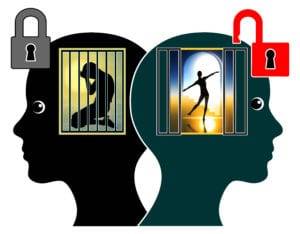
EMDR: A Power Tool for Healing the Brain
Trauma Recovery & Beyond
By Karin Witte, LMHC
EMDR (Eye Movement Desensitization and Reprocessing) is a powerful therapeutic technique for trauma recovery which has proven success in recovering from distressing, often disabling emotional and psychological distress.
There are 2 major types of trauma. Developmental trauma results from childhood abandonment, abuse, and neglect. Shock trauma results from severe, often violent events at any stage of life. EMDR is highly effective in helping trauma survivors with anxiety, panic, disturbing memories, post-traumatic stress (PTSD) and other emotional problems.
How EMDR Works
EMDR works to specifically target the stored traumatic experiences in the brain. It essentially restarts the frozen or stuck information by accessing the nervous system, which is the basis for the mind/body connection; i.e. fight or flight response when the brain senses danger and tells the body to run.
In trauma recovery using EMDR, memory networks are activated, so that new information can be added to help resolve traumatic experiences in a more productive and positive way by stimulating both sides of the brain through eye movement. This is similar to what happens in REM sleep when we dream – we can allow the brain to release the distressing emotional experiences that are “trapped” in our memory networks.
Simply through eye movement, the brain frees itself up to be able to process the experience in a more functional and less distressing way. As troubling images and feelings are processed, resolution and a more peaceful state are achieved. It’s actually your own brain healing itself while you are the one in control of processing the memory.
What EMDR doesn’t do is:
- Remove the memory; you still remember it, but at a more distant, vague and less distressing level;
- Remove any information that is valid or that you need to hold on to for your well-being.
What Happens During EMDR Sessions
EMDR generally starts with several sessions where the therapist will take a thorough history, explain the procedure in detail and address any questions or concerns. These initial sessions are key to the process and allow for a safe trusting working relationship, which is imperative to the deeper work of trauma recovery.
During EMDR, the client focuses on a traumatic event and the accompanying body sensations while following the therapist’s fingers with his or her eyes. The therapist moves her/his fingers back and forth or uses “tappers” that the client holds in his or her hands for tactile stimulation. This process is repeated several times until the client no longer feels distress when thinking about the upsetting memory.
Benefits of EMDR
EMDR specifically targets the area in the brain where distressing information is stored by while also integrating therapeutic methods to promote the mind/body connection. The goal in EMDR is to resolve past trauma while maintaining stabilization in the present. It also helps survivors and those with PTSD to access internal resources to cope with any distressing situations that may arise in the future. The following is a snapshot of EMDR benefits:
| Before EMDR | After EMDR |
|
|
| What Happens: | What Happens: |
|
|
| Negative Consequences: | Positive Results: |
|
|
EMDR & Trauma Recovery – A Personal Experience
My own experience with EMDR reflected this snapshot perfectly. I saw an EMDR therapist to resolve my trauma of losing someone close to me who drowned in the ocean. Prior to these sessions, I suffered with symptoms of PTSD: panic attacks, anxiety and a sense of powerlessness. I was also afraid of my lack of control in the ocean when faced with a strong current. After EMDR, I once again found myself in the midst of an overpowering ocean current and as the current began to take me out to sea, I was able to remain calm and grounded; knowing exactly what I needed to do to get back to shore safely.
It was the positive result of the trauma recovery work I had done in EMDR that allowed me to remain calm and safe in the face of a potentially dangerous situation. I was amazed there was no emotional charge whatsoever! I knew right then I wanted use EMDR to assist other people who suffer from trauma and help them live their best life and reach their full potential.
As I incorporated EMDR into my therapy practice, both my clients and I have experienced significant benefits of this trauma recovery method. As a therapist, the gift of witnessing the positive results that EMDR provides for my clients is one that continues to give; it is my honor to be a guide in the healing of others and I’m privileged to have found such an efficient and effective treatment method.
If you or someone you know has experienced trauma; during childhood or as an adult, and are suffering the negative and lasting effects it has, please know you’re not alone and resolution is possible.
To learn more about trauma recovery and how I can help you in your healing process, please feel free to contact our Center today.







